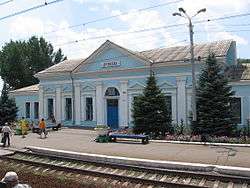Druzhkivka
| Druzhkivka Дружківка | |||
|---|---|---|---|
| City | |||
| |||
 Druzhkivka | |||
| Coordinates: 48°37′17″N 37°31′40″E / 48.62139°N 37.52778°ECoordinates: 48°37′17″N 37°31′40″E / 48.62139°N 37.52778°E | |||
| Country | Ukraine | ||
| Oblast | Donetsk | ||
| Founded | 1780s | ||
| Area | |||
| • Total | 34 km2 (13 sq mi) | ||
| Population (2001) | |||
| • Total | 64,557 | ||
| Website | http://druzhkovka.com/ | ||
Druzhkivka (Ukrainian: Дружківка, Russian: Дружковка, Druzhkovka) is a city of oblast significance in Donetsk Oblast (province) of Ukraine. Population: 59,863 (2013 est.)[1]; 64,557 (2001). The area of the city is 46 km².
Druzhkivka is a city located near the confluence of the Kryvyi Torets and Kazennyi Torets rivers, about 80 km to the North-East from the regional center - Donetsk.
History
Historical records indicate that a settlement named Druzhkivka was established in this area by 1781 A.D. From the late 19th through the 20th century, Druzhkivka grew into a mid-size industrial city with several large factories producing mining equipment and machinery, hardware, kitchen stoves, china tableware and bricks, as well as several clay-extracting quarries in the city's vicinity. The economic collapse that resulted from the breakup of the Soviet Union resulted in the rapid decline of the local industries, with factories closing or barely functioning — a condition that led to high unemployment and a population exodus. This was exacerbated by the reality that many former residents came to the city from all across the Soviet Union solely to get employment in the once booming industries. When the jobs disappeared, lots of them moved away. The current population of less than 60,000 is well below the historical high of at least 80,000 during the mid-1980s. At this time, a large number of residents are guest workers in various foreign countries. However, since guest workers bring their incomes back home to spend, this led to the rapid growth in the local services and retail industries.
During World War II, Druzhkivka was occupied by the German Army from October 22, 1941 to February 6, 1943 and again from February 9 to September 6, 1943. During their occupation, they killed many local Jews. A witness from the village described the Germans hanging the Jews of the village along the railway.[2]
During the 2014 pro-Russian conflict in Ukraine the town was captured in mid-April 2014 by pro-Russian separatists.[3][4] The city was eventually retaken by Ukrainian forces on 7 July 2014, along with Artemivsk.[5][6]
Demographics
Ethnicity as of the Ukrainian Census of 2001:[7]
- 48,302 Ukrainians (64.4%)
- 24,122 Russians (32.2%)
- 612 Armenians (0.8%)
- 490 Belarusians (0.7%)
- 216 Tatars (0.3%)
Native language as of the 2001 census:[8]
- Russian 70.3%
- Ukrainian 28.4%
- Armenian 0.5%
- Belarusian 0.1%
Municipality
Settlements subordinate to Druzhivka city include:
- Druzhkivka (Дружківка)
- Mykolaipillia (Миколайпілля)
- Novohryhorivka (Новогригорівка)
- Novomykolaivka (Новомиколаївка)
- Oleksiievo-Druzhkivka (Олексієво-Дружківка)
- Raiske (Райське)
Gallery
 Druzhkivka tram
Druzhkivka tram Railway station
Railway station- Plumber monument in Druzhkivka
External links
| Wikimedia Commons has media related to Druzhkivka. |
- (Russian) druzhkovka.com - Druzhkovka city portal
- (Russian) druzhkovka.info - Wiki-based website about Druzhkivka
References
- ↑ "Чисельність наявного населення України (Actual population of Ukraine)" (in Ukrainian). State Statistics Service of Ukraine. Retrieved 21 January 2015.
- ↑ "Yahad-In Unum Interactive Map". Execution Sites of Jewish Victims Investigated by Yahad-In Unum. Retrieved 10 February 2015.
- ↑ http://www.newrepublic.com/article/117387/putin-accidentally-helping-unite-eastern-and-western-ukraine
- ↑ http://en.itar-tass.com/world/735082
- ↑ http://www.bbc.com/news/world-europe-28191833
- ↑ http://en.interfax.com.ua/news/general/212315.html
- ↑ http://www.webcitation.org/6CURge2tu
- ↑

